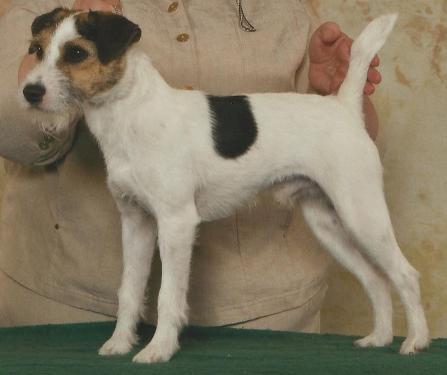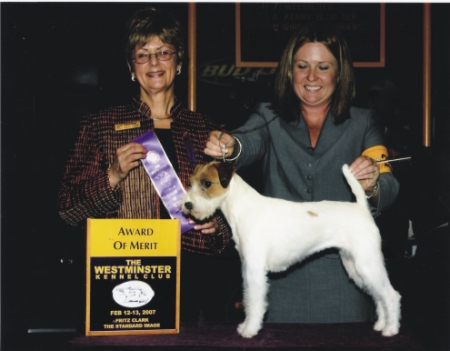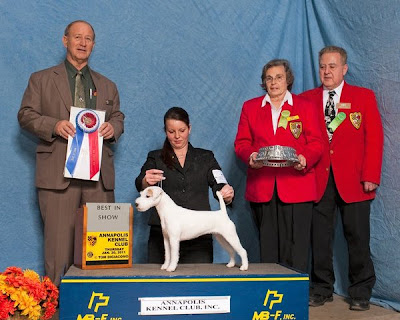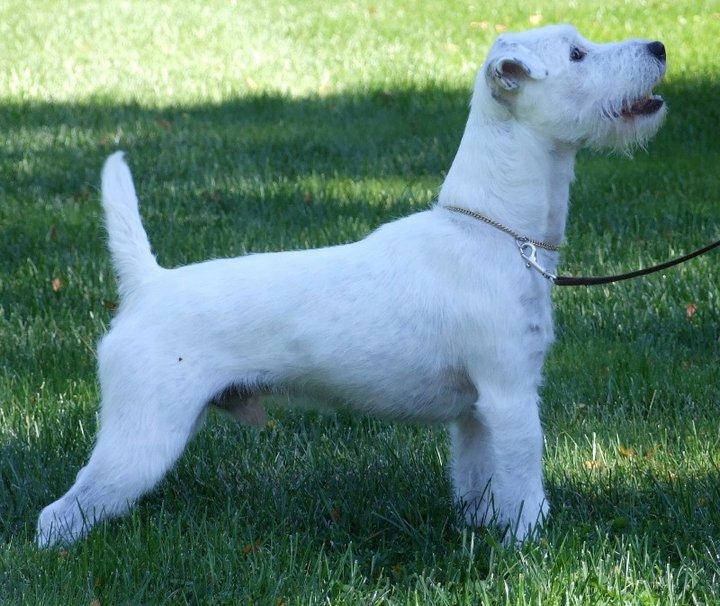Breed History

ABOVE - Can GCH Caudlewood Naughty Nature bred by Gail Caudle and W. Addison White owned by Gail Caudle and Davine Walsh. Austin was the first Canadian Grand Champion.

ABOVE - The first female to earn points toward a Canadian Championship was Am/Can Ch. Rednock Honey Bunch ROMowned by David and Susan Crawford (Foxbend Kennels) and bred by Christiane Lindenburg-Beste.

ABOVE - BIS/BISS Am../Can. Ch. Foxbend Colour Me More - Breeder/Owner - David and Susan Crawford Sire: Am. Ch. Thunderhill Soul Journey Dam: Am/Can. Ch. Rednock Honey Bunch - Handler Dana Bryson. Winner of the first Canadian National, September 4th, 2010 Halifax Nova Scotia underJudge Sally Yancey
The breed we love today.......a brief history
The following are two articles written by Liz McKinney of Falling Branch Kennels, VA, USA
Thanks to Liz for allowing us to use her articles on this website. Please note the first article was written before the official name change of the breed.
History of the Jack Russell Terrier—a compilation from historical sources
by Liz McKinney
There is complete agreement among historians that our present day Jack Russell Terrier developed as a strain or type of working terrier along with the Wire and Smooth Fox Terriers in Britain. Both the Jack Russell Terrier and the Wire and Smooths came from the same types of stock, but quickly diverged both in type and in use as working and show dogs.
The early 1860s may be fixed as the approximate starting point in both smooth and wire history. Undoubtedly the majority of the smooths originated from the hunts, notably the Grove, Oakley, Quorn and Belvoir. These hunts had maintained strains of terriers for many years prior to this period, but no record was kept of their breeding. Every terrier simply had to be a workman. When the dog show movement began these hunt clubs brought to the shows those of their terriers which they believed would most nearly meet the fancy of the judges.
It must be remembered that until 1976 no standard had been drawn up and judges placed the prized upon whatever dogs, so to speak, caught their fancy. Notwithstanding the fact that all sorts and kinds of so-called Fox Terriers were brought out, and not withstanding the differences in opinion between judges as to the correct type, we find that three terriers found their way quickly to the top of the heap, and held their positions for several years thereafter. These are the terriers responsible for most of the subsequent winners in years to follow. Their names lie in remote generations behind the terriers exhibited today.
First and foremost, and at the head of affairs was Old Jock’ second, Old Trap; and third Old Tartar. This was the trio of unbeatables.
Old Jock was born in 1859, and in make and shape to a greater extent than any of his contemporaries was a terrier in the modern sense of the word. His breeding, however, has always remained in dispute, although most records credit Captain Percy Williams, master of the Rufford Hounds, as breeder, while others credit Jack Morgan, first whip to the Grove. The facts, however, seem to prove that Captain Williams owned his sire, also known as Jock, and that his dam, Grove Pepper, was the property of Jack Morgan, one of the famous Morgan family of huntsmen. Jock’s sire and dam, although of unknown lineage, came from many generations of the gamest working stock.
It is a fact that Old Jack showed far less of the bullterrier cross than did his contemporaries, notably Tartar, whose antecedents were, to say the least, questionable. The fact that Tartar emanated from the kennels of Mr. Stevenson of Chester, whose dogs were practically bullterriers with drop ears and docked tails, gave credence to the speculation above noted. Notwithstanding all of this, Tartar was a great dog, both as a showman and workman, and game to the core.
Old Trap, the third member of the triumvirate, was bred by Colonel Arkwright, master of the Oakley. The dog was descended from a long line of Oakley terriers, most of which were doubtless black and tan in color.
The earliest known breeder of Fox Terriers in the world was the Rev. John Russell, or “Parson Jack” as he came to be called, of Barnstaple, Devonshire, England. He started his strain while a student at Oxford when but 18 years of age. This was in 1813, and more than fifty years afterwards had pedigrees that he could trace back to the time when he first began breeding his terriers.
Before considering Russell’s activities in the terrier world, it may prove of interest to learn something of the so-called “sporting parson” himself. Russell was the son of a rector of Iddesleigh, in Devonshire. He was born in 1795 and lived to the ripe age of eighty-eight. In many ways he is said to have been an extraordinary man—six feet tall, of hardy and robust appearance, yet to kind and gentle that all who knew him loved him and were charmed by his affability.
Russell was an expert horseman and throughout all of Devonshire he was famous as a huntsman. His terriers ran along with the hounds, drawing the earths as they came to them. The parson’s dogs possessed dense but somewhat short wire coats. This he considered the “true and correct jacket” for a Fox Terrier.
Russell’s terriers were seldom if ever exhibited, as their owner was not an admirer of the Fox Terrier as ordinarily bred for the show ring. His sole idea in breeding was to produce workers. It is said, however, that his terriers could have given good accounts of themselves in competition with any of the show terriers of their day.
Although for many years a member of the English Kennel Club, Russell consistently declined invitations to judge at dog shows. He “donned the ermine” upon but one occasion. It was at the Crystal Palace, 1874, but he said at the conclusion of the judging that the terriers he saw failed to impress him.
Russell’s terriers, in working condition, did not scale more than fifteen pounds, some even less, and fifty years ago they formed a very distinctive type. The “Jack Russell terrier” is frequently referred to today by breeders when speaking of a small, hard bitten, compactly built terrier.
Russell entered his terriers at fox when they were very young, and was a great believer in having the youngsters learn their trade from the old seasoned veterans. He never permitted his dogs to be entered at any other quarry than fox.
After Russell’s death, the only persons who made a serious attempt to carry on the strain were Mr. East, of Chiselhurst and Mr. Archer, of Cornwall. The former at one time had seven or eight couples, all of which were descended from Russell’s Fuss.
After the turn of the present century John Mowlem of Swanage vainly attempted to collect some of the descendants of Parson Jack’s strain. Doubtless, however, many of the little nondescript wires today seen running about Devonshire villages are lineal descendants of the Russell terrier, but positive proof of such is, of course, impossible.
The Reverend Russell kept, bred and wanted his terrier for one and only one reason which was to tease and worry a fox, not to kill him. “A real fox-terrier,” he would say, “is not meant to murder and his intelligence should always keep him from such a crime.” .
According to the obituary notice in the “Kennel Gazette” of May, 1883, Russell was said to have prided himself that his terriers never tasted blood, but that they could not lose their way, and that their eye to a country was so marvelous and their memories were so great that no sooner were the hounds out of cover than some of his terriers would be miles away getting to well-known earths in time to stop the fox getting in.
The type he aimed at were hardly as big as the show fox-terrier. Few were over 15 lbs. when in working condition, and many were less. By 1850 there were definitely recognized as a distinct type. The late Hon. Gerald Lascelles, who knew Rev. Russell, often stated that the parson himself said that he had no strain, merely a type, for he bought any good terrier of the right stamp that he came across and could afford.
It was said by Mr. Robert Leighton, the well-known doggy writer that Russell said, “A fox-terrier is not required to draw badgers, nor should be such a hard biter as to slaughter a fox in his earth. The bull blood would in all probability produce this impetuosity, and destroy the gentlemanly character of the strain entirely.”
Arthur Blake Heinemann has been often credited with setting the breed standard and type in the kennel club, but it is a misnomer that Heinemann had any contact with either Rev Russell or his terriers or that he hunted fox to any extent. It has often been suggested Heinemann was one of those who acquired some of the Parson’s own terriers. Heinemann, however, was not a fox hunter but was rather a badger digger. Heinemann was only eleven years old when the Parson died and so was very unlikely to either to inherit or be in a position to buy any terriers from the estate. In fact, on Heinemann’s own evidence, which was far more likely to be exaggerated than understated, he only began breeding terriers over twenty years prior to 1912. That would put his debut as a breeder in the early 1890s and not the early 1880s when the Parson died. There is no evidence that Heinemann and the Parson ever met.
In 1894, Heinemann founded the Devon and Somerset Badger Club. Its aims were to encourage an interest in badger digging and the breeding of terriers suitable for the purpose. The terriers were acquired from Nicholas Snow of Oare and it is possible, even likely, that the blood of the Parson’s terriers ran in their veins, though by now in a diluted form. Snow had started the Exmoor Hounds in 1869 and was to remain Master until 1889. The Parson would certainly have hunted with “The Stars of the West,” as they were called, and it is more than likely that at least some of their original terriers were supplied by him.
After the very brief interlude as Master of the Cheriton, Heinemann concentrated his sporting activities on badger digging and, immediately after he ceased to be Master of the Cheriton, changed the name of his Devon and Somerset Badger Club to the Parson Jack Russell Terrier Club. Possibly the change was intended as a means to enhance the value of the terriers which Heinemann was by now producing and selling in large numbers, but whatever the reason the change had the effect of helping to perpetuate the name of the Parson Jack Russell Terrier, albeit attached to a terrier very different from that which the Parson bred. Badger digging required a different stamp of terrier than those bred to run with hounds and to work to fox. It is likely that Heinemann introduced Bull Terrier blood, which the Parson so abominated, in order to produce the sort of strength and aggression which would enable his terriers to face badgers and from the photographs we have of Heinemann’s terriers, it seems probable that the short-legged terriers, which are often wrongly associated with the Parson himself and to which his name is often attached, may have their origins in the activities of the Devon and Somerset Badger Club. The split which was developing between show and working Fox Terriers was now compounded by a further split between the two very different types of terrier both of which carried the Parson’s name.
Nevertheless, though Heinemann may not have been the most careful or scrupulous of breeders, he was sufficiently concerned about what was seen as the split between show and working Fox Terriers to accept an invitation, in 1909, to judge a number of classes for working terriers at Crufts. The aim was to bring working terriers back into the show ring, and so to bring influence to bear on those who chose to disregard working qualities. In subsequent years the classes were judged by various Masters of Hounds but were never well filled and after a few years Charles Cruft, never a man to pursue a lost cause, abandoned the attempt.
Heinemann died, aged 59, in 1930 and his kennel of terriers went to his kennel main Annie Harris. Annie Harris then became housekeeper to Henry Williamson and must have found her situation very different there. Williamson was not a fan of badger digging at all. It was not an experience he enjoyed and it may well have killed any interest he might have had in terriers. Perhaps it is not surprising that he found no interest in the papers from Russell and Heinemann, which Mrs Harris brought with her when she became his housekeeper. Possibly the papers are not irretrievably lost, though it is equally possible that they are tucked away in some neglected corner.
Williamson’s lack of interest in terriers did not prevent Mrs Harris from continuing to breed them. By using the often iniquitous system of letting bitches out on breeding terms she was able to produce a great many so-called Jack Russell Terrier whose popularity spread far beyond Devon. They were to be found throughout Britain and were exported all over the world.
Concern about the alleged split between show and working types and the very closely related efforts to perpetuate the type of terrier bred by the Parson has not subsided, though in future both concerns would be less closely associated with the Fox Terrier Club itself. It is apparently, however, that though committed to evolution the Club did not stand in the way of those among their members who wished to preserve the sort of terrier bred by Parson Jack Russell and even went so far as to offer them the help which affiliation to the Club provided. The support given to the preservationists was far sighted. We have only recently come to realize that the preservation of old breeds of farm and other animals whose economic usefulness may seem to have long passed or which have been bypassed by fashion, may well enable us to preserve genes, and characteristics produced by those genes, which may be of great value in the future.
It is impossible to say precisely when the terriers bred by the Parson became sufficiently distinctive as to be regarded as a breed in their own right. We would suggest that there is sufficient evidence to show that this took place during the Parson’s lifetime, but it doesn’t much matter if others would prefer a later date. What is important is that the Parson’s terriers did form a distinct type and this type is now so different from both Smooth and Wire Fox Terriers and from the terriers of the type developed by Heinemann and his successors, which are often referred to as Jack Russell Terriers, that it is worth recognizing and, more importantly, preserving as a breed in its own right.
The Parson Russell Terrier--an earthworking breed
by Liz McKinney
The Parson Russell Terrier is a breed that has been maintained as an earth working terrier since the 1800s. In light of this we must examine the PRT, its roots and its function at is was in the 1800s and as it remains a working terrier in its country of origin by the professional working terrier men in the registered and organized hunts today.
This breed entered the AKC under the name of the Jack Russell Terrier. The name was changed to Parson Russell Terrier in April 2003, but remains the same terrier as it was prior to the name change. The British roots of this terrier, both in registration and in bloodlines, can be found in the Jack Russell Terrier Club of Great Britain (JRTCGB) years before the Parson Russell Terrier club in England was formed. In fact, the founders of the PRT club came out of the JRTCGB, broke away from that club and founded the stand alone club that sought and was granted TKC recognition for this breed.
The breed standard of the JRTCGB (the predecessor of the modern day PRT club) is 10” to 15” with the average size of 12.5” at the withers for a very good reason. The terrier men and women in England have long worked this terrier in the earth to red fox. That is the breed’s history, its function, its purpose for being. The Reverend John Russell, credited as the progenitor of this breed, lived in the south of England in Devonshire where the size of the earths were and still are such that a terrier must be on the small size to be able to enter. To this day the PRTs used in the area where the Rev. Russell lived and hunted are 12.5” and under terriers to be able to get into the earth to get to the fox.
Anyone who claims that any breed of earth working terrier gets to his quarry by “digging and forcing his way in” just does not understand earth work as anyone who has regularly worked red fox either in America or England will attest . A terrier MUST be of the size to enter the earth quickly and pursue the fox in his den without hesitation and without a remarkable time lapse. If he cannot enter quickly and get to the fox in short order, he will never be able to get to his quarry. It would, in short, be an exercise in futility. The wild fox is not going to patiently wait on the terrier to find him. This is not a game with an obedient, domestic fox.
English earths are deep and intricately woven with many tunnels and side tunnels, and accordingly a terrier that must dig and force his oversize body through the earth is a useless terrier for the purpose of hunting. Try conjuring a picture in your mind of a mounted hunt waiting for hours upon hours for a large bodied terrier to dig and claw his way through hundreds of feet of tunnels underground looking for his quarry. Regardless of the flexibility of body or chest one cannot push a 17” or 18” chest through a 16” earth!
It is also clearly a misunderstanding that this terrier must be of sufficient size to possess the strength to face a red fox. Facing a red fox does not take strength, but rather it takes brains and cunning. Never was this breed used to grab or kill its quarry in the ground. Instead, the Parson Russell Terrier was bred to worry the fox and to bolt it from its den so that the hunt could continue. In order to do that, this breed must be small enough to get to the fox in short order and to maneuver under ground in order to bolt the quarry. A PRT that kills a fox is a PRT that will not be allowed to remain in the hunt kennel. A PRT that injured a fox was one that the Rev. Russell culled immediately from his pack according to his own words (See A Memoir of the Rev. John Russell.)
Let us all use some common sense. Try picturing a 14” terrier running all day with a pack of over 30” tall Foxhounds and then when the fox is run to earth by those hounds, the terrier must work, squeeze and dig his way into an earth too small for the terrier to easily enter to get to his quarry. Show us any breed of terrier that stands only 12” to 15” that can do all of this. It is literally impossible.
And finally, the PRT club in England has opened its stud book specifically to allow the inclusion of the smaller, under 12” terrier because the size of the PRTs has become, on average, too large to be useful. With the size in the show ring clearly going up and up it won’t be long before the AKC is forced to do the same thing if the fancy cares at all about keeping this breed true to its roots so that it can enter and pursue the red fox and bolt that fox unharmed.
